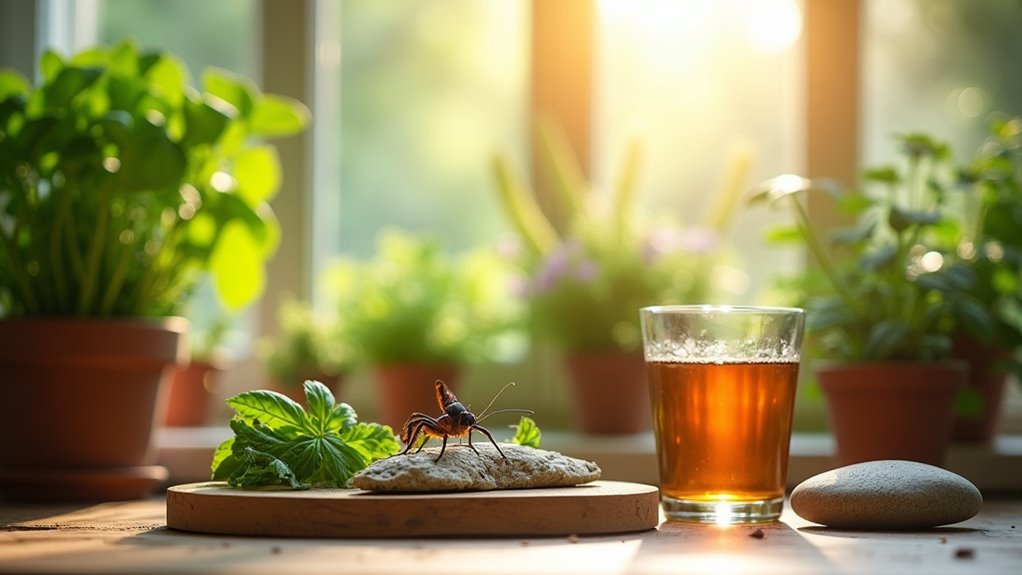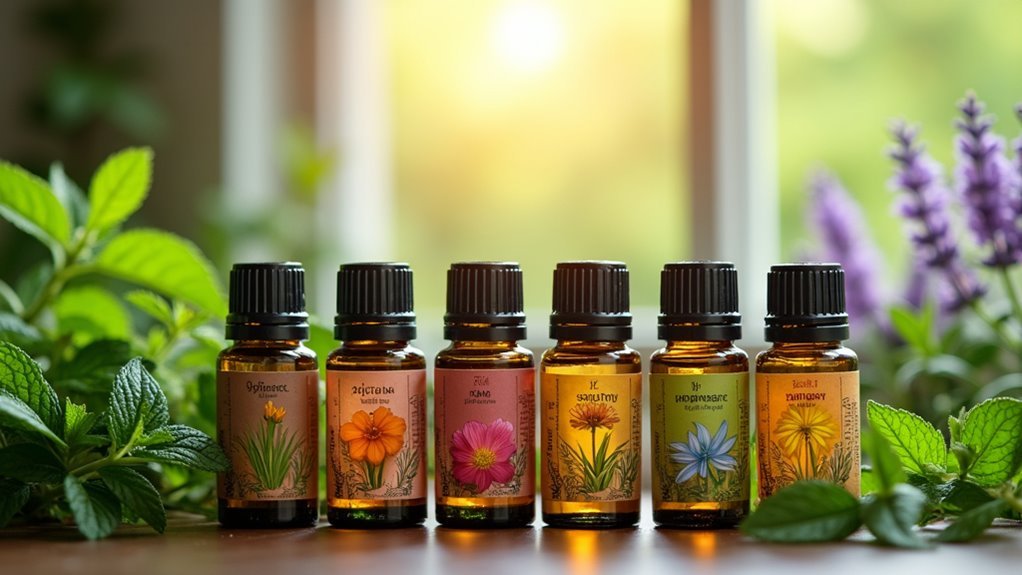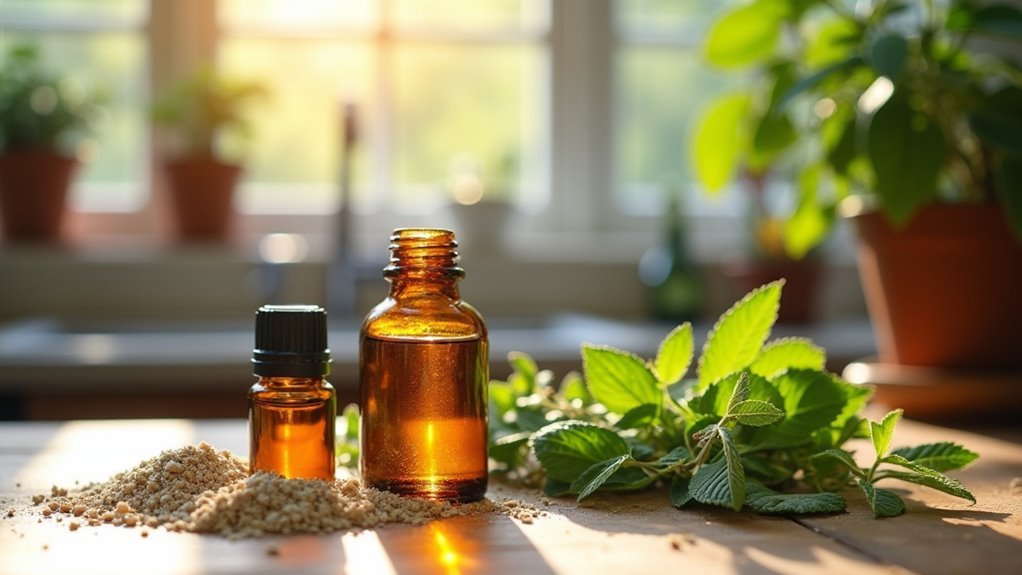You should choose natural cockroach control methods because they protect your family’s health by eliminating harmful pesticide exposure, especially for children and pets with respiratory sensitivities. Natural alternatives like peppermint oil and vinegar create effective barriers without toxic residues, while being considerably more cost-effective than commercial pesticides. These methods also preserve environmental quality by avoiding soil and water contamination. Understanding cockroach behavior helps you apply these solutions strategically for maximum impact and long-term prevention.
Health Benefits of Chemical-Free Pest Control

When you choose chemical-free cockroach control methods, you’re protecting your family’s health while effectively managing pest problems.
Natural solutions like diatomaceous earth and essential oils eliminate harmful pesticide exposure, reducing health risks for everyone in your home, especially children and pets with respiratory issues or chemical sensitivities.
Natural pest control methods protect vulnerable family members from toxic exposure while maintaining effective cockroach elimination in your home.
You’ll notice improved air quality when switching to chemical-free pest control, as conventional pesticides release volatile organic compounds that contribute to indoor pollution.
Natural repellents such as garlic and peppermint oil effectively deter cockroaches without leaving toxic residues that could trigger allergic reactions.
These eco-friendly practices align with holistic wellness philosophies, supporting a lifestyle that prioritizes safety and sustainability over synthetic chemicals in your home maintenance routine.
Environmental Impact of Natural vs. Synthetic Methods
While natural cockroach control methods protect your family’s health, they also create a dramatically smaller environmental footprint than their synthetic counterparts.
Synthetic pesticides contaminate soil and water sources, persisting for extended periods and causing bioaccumulation in wildlife. These chemicals disrupt local biodiversity and create ecosystem imbalances that can last for years.
Natural cockroach alternatives break down safely and quickly, supporting sustainable practices. When you choose eco-friendly pest management techniques like diatomaceous earth, neem oil, or essential oils, you’re protecting:
- Water quality – preventing chemical runoff into streams and groundwater
- Soil health – maintaining beneficial microorganisms and earthworms
- Wildlife diversity – protecting birds, bees, and other non-target species
Every natural repellent you use contributes to a healthier planet while effectively managing pest problems.
Safety Considerations for Families and Pets

When you’re dealing with cockroaches in your home, you’ll want pest control methods that won’t put your family or pets at risk.
Natural cockroach control ingredients like diatomaceous earth, essential oils, and vinegar offer non-toxic alternatives that effectively repel roaches without the dangerous chemical residues found in synthetic pesticides.
You can confidently use these natural solutions around children and pets, knowing they won’t cause respiratory issues, allergic reactions, or accidental poisoning.
Non-Toxic Ingredient Benefits
Although chemical pesticides may promise quick results, you’ll find that natural cockroach control methods offer something far more valuable: complete safety for your family and pets.
Non-toxic ingredients like diatomaceous earth, baking soda, and essential oils deliver effective results without compromising your household’s health.
These DIY solutions eliminate the respiratory issues and skin irritations commonly associated with chemical pesticides. You’ll particularly appreciate how safe these methods are around sensitive individuals, including children and elderly family members.
Consider these powerful non-toxic options:
- Peppermint and tea tree oil – Create aromatic barriers that repel roaches naturally
- Baking soda and sugar baits – Attract cockroaches without endangering pets
- Diatomaceous earth – Provides long-lasting protection with zero chemical exposure
This eco-friendly pest control approach protects your environment while effectively managing infestations.
Child and Pet Safety
Your family’s safety becomes the top priority when selecting pest control methods, especially if you have young children or pets who spend time on floors where treatments are applied.
Natural cockroach control eliminates the worry of toxic chemical exposure that comes with conventional pest control services. Children and pets won’t encounter harmful residues when crawling, playing, or eating in treated areas.
Diatomaceous earth and essential oils like peppermint provide effective results without compromising child safety or pet safety.
These natural solutions focus on prevention and hygiene rather than dangerous chemicals. You’ll gain peace of mind knowing your home remains protected from pests while maintaining a healthy environment.
Natural methods guarantee your family’s well-being isn’t sacrificed for pest elimination.
Cost-Effectiveness of DIY Natural Solutions
You’ll find that natural cockroach control methods offer significant financial advantages over commercial pest control services.
Most DIY solutions use common household ingredients like baking soda, sugar, and vinegar that cost just pennies compared to expensive professional treatments.
These budget-friendly approaches require no special equipment and can deliver long-term savings while effectively managing minor to moderate infestations.
Budget-Friendly Ingredient Options
Three common household ingredients can transform your cockroach control strategy without breaking the bank.
These budget-friendly options deliver powerful results while keeping costs minimal.
Your pantry likely contains these effective DIY natural solutions:
- Baking soda and sugar mixture – Creates a deadly combination that attracts roaches while eliminating them affordably.
- Essential oils like peppermint and tea tree – Provide long-lasting repellent properties at a fraction of professional service costs.
- Diatomaceous earth – Covers extensive areas with just small amounts, offering extended protection per purchase.
You’ll find that vinegar and lemon juice create cost-effective homemade sprays that simultaneously clean and deter roaches.
These ingredients cost considerably less than commercial pesticides while addressing minor infestations effectively.
Long-Term Savings Benefits
Beyond the immediate affordability of these natural ingredients, the real financial advantage emerges when you consider their long-term impact on your household budget. Natural pest control creates sustainable cockroach infestations prevention that eliminates recurring professional pest control expenses.
| Method | Initial Cost | 5-Year Savings |
|---|---|---|
| DIY Natural | $20-50 | $1,500-2,500 |
| Professional Monthly | $100-200 | $0 |
| Chemical Treatments | $75-150 | $500-1,000 |
| Prevention Focus | $30-75 | $2,000-3,000 |
| Emergency Services | $300-500 | -$1,500 |
You’ll avoid the $100-500 pest control service fees while maintaining effective prevention. Consistent natural methods create hostile environments for roaches, reducing future cockroach infestations. This proactive approach delivers substantial long-term savings compared to reactive chemical treatments that require frequent reapplication.
Equipment-Free Application Methods
Since most natural cockroach control methods require nothing more than items you already have in your kitchen, you can start implementing these solutions immediately without purchasing specialized equipment.
You’ll find that common household items transform into powerful natural deterrents with simple preparation techniques.
Three equipment-free cockroach control applications include:
- Essential oil spray – Mix peppermint or tea tree oil with water in any spray bottle.
- Vinegar solution – Combine equal parts vinegar and water for direct surface application.
- Baking soda bait – Blend baking soda with sugar using just a spoon and bowl.
You can place dried bay leaves directly in infested areas without any tools whatsoever.
These versatile kitchen ingredients let you tackle multiple cockroach control strategies simultaneously, eliminating expensive equipment investments while maintaining effective pest management.
Understanding Cockroach Behavior for Targeted Control
When you understand how cockroaches behave, you’ll gain a significant advantage in controlling them naturally. These nocturnal pests actively search for food and water during nighttime hours, making targeted evening applications of natural repellents most effective.
Since cockroaches possess strong olfactory senses, you can repel roaches using scents like peppermint or tea tree oil in their preferred hiding spots.
Their rapid reproduction means cockroach populations can explode quickly—German cockroaches produce over 30,000 offspring annually.
You’ll need to eliminate moisture and food sources that attract them while understanding their relocation patterns when encountering repellent odors. This behavioral knowledge forms the foundation of effective integrated pest management, allowing you to strategically place natural deterrents where they’ll have maximum impact on disrupting cockroach habitat preferences.
Essential Oils and Plant-Based Repellents

Building on your knowledge of cockroach sensitivities to strong scents, you can harness the power of specific essential oils to create effective natural barriers.
These potent solutions work across different cockroach species by exploiting their aversion to particular aromas.
The most effective essential oils include:
- Peppermint oil – Creates an invisible shield that cockroaches actively avoid crossing.
- Tea tree oil – Penetrates cracks and crevices where cockroaches hide during daylight hours.
- Eucalyptus oil – Overwhelms their sensory receptors, forcing them to seek shelter elsewhere.
You’ll enhance results by combining these oils with plant-based repellents like crushed bay leaves and catnip.
Mix water with lemon juice as an additional natural deterrent that simultaneously cleans surfaces and removes attractant residues.
Physical Exclusion and Habitat Modification Techniques
While essential oils repel cockroaches through scent, you’ll achieve longer-lasting results by physically blocking their access and eliminating the conditions they need to survive.
Physical exclusion starts with sealing cracks and crevices around windows, doors, and walls using caulking or weather stripping. These simple barriers prevent cockroaches from entering your home initially.
Habitat modification focuses on removing what attracts them. Fix leaks and use dehumidifiers to reduce moisture levels that cockroaches crave. Store common household items like food in airtight containers and use sealed garbage bins.
Keep your exterior tidy by trimming shrubbery away from foundations and preventing mulch contact with siding. Regularly inspect basements, attics, and garages to eliminate potential hiding spots and nesting sites where cockroaches might establish themselves.
Limitations and Realistic Expectations of Natural Methods
Physical barriers and habitat changes form the foundation of natural cockroach control, but you must understand their inherent limitations before setting your expectations.
Natural solutions often provide temporary relief rather than complete elimination, especially with severe infestations where populations can grow unchecked.
These methods face three critical challenges:
- Variable effectiveness – Essential oils and diatomaceous earth may only relocate cockroaches to new hiding places.
- Maintenance demands – You’ll need consistent reapplication since natural deterrents don’t offer immediate results.
- Environmental dependency – Humidity and available food sources greatly impact success rates.
You can’t rely solely on natural methods for established infestations.
They work best when you simultaneously remove food sources and address underlying conditions that attract these pests.
When Natural Methods Should Be Combined With Professional Help
Although natural methods offer valuable benefits for cockroach prevention, you’ll need to recognize when they’re insufficient for your situation.
Natural cockroach control methods work best for minor problems but lack the strength required for a severe infestation. When you’re dealing with extensive roach populations, you should combine natural repellents like diatomaceous earth with professional help to create a thorough approach.
For extensive cockroach infestations, natural methods alone aren’t enough—combine them with professional pest control for effective results.
Professional pest control becomes essential in multi-family buildings where roaches spread rapidly between units. These experts target both adult roaches and their eggs, reaching hidden nests that natural solutions can’t eliminate effectively.
If your home has experienced severe infestations before, use natural methods as supportive strategies alongside professional intervention rather than standalone solutions for long-term success.
Frequently Asked Questions
What Is the Best Method of Cockroach Control?
You’ll find the most effective cockroach control combines diatomaceous earth application, essential oil sprays, strategic placement of garlic-bay leaf mixtures, and consistent vacuuming while maintaining cleanliness throughout your home.
Do Natural Roach Repellents Work?
Natural roach repellents do work for minor infestations. You’ll find essential oils like peppermint effectively deter cockroaches through strong scents. However, you shouldn’t rely solely on them for severe infestations requiring extensive approaches.
What Is the Best Natural Deterrent for Cockroaches?
You’ll find diatomaceous earth works best as it physically damages cockroaches’ exoskeletons, causing dehydration. Peppermint oil’s also highly effective since its strong scent overwhelms their sensitive smell receptors, making treated areas uninhabitable.
What Is the Most Effective Cockroach Control?
You’ll achieve the most effective cockroach control by combining sanitation, exclusion, and baits. Remove food sources, seal entry points, use gel baits, and maintain regular cleaning schedules for thorough results.
In Summary
You’ve discovered that natural cockroach control offers safer alternatives for your family while protecting the environment. You’ll reduce health risks from toxic chemicals, save money with DIY solutions, and create long-term prevention through habitat modification. However, you must maintain realistic expectations about their effectiveness. When facing severe infestations, you shouldn’t hesitate to combine natural methods with professional intervention. You’re now equipped to make informed decisions about protecting your home sustainably.





Leave a Reply